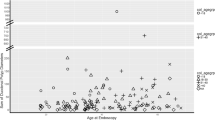Abstract
The flat adenoma is an endoscopically visible lesion that histologically consists of adenomatous change near the luminal surface of colonic tubules. We have described three families with hereditary colon cancer with later age of onset than familial adenomatous polyposis (FAP) and with multiple proximal colonic flat adenomas. These families have been linked to the FAP locus on chromosome 5. Our aim was to determine whether the flat adenoma is pathognomonic of this hereditary flat adenoma syndrome (HFAS) or merely an atypical or early tubular adenoma with occurrence in patients other than those from colon cancer-prone families. Methods: We prospectively examined a population referred for colonoscopy within a one-year period. During colonoscopy, flat adenomas were specifically sought and all lesions were removed endoscopically and evaluated histologically. Members of known hereditary colon cancer families were excluded. Results: One hundred forty-eight patients underwent colonoscopy (64 men and 84 women). Median age was 61 years. Fifty-seven patients had 157 polyps. One hundred thirty-six polyps were reviewed histologically. Thirty-five (23.6 percent) of the referred patients had adenomas, of whom twelve patients had only flat adenomas while six had both flat and other adenomas (18=12 percent of 148). The associations between flat adenoma occurrence and various predictors (sex, race, prior colonic neoplasms, family history of cancer, synchronous adenomas) were similar to those seen with other adenomas. Flat adenomas were found in nearly equal proportions of patients under or over age 61 years (11 percent and 13 percent, respectively). Other adenomas were significantly more common in the older group (6 percent vs.25 percent;P <0.002 by Fisher's exact test). Conclusion: In a referral practice, the flat adenoma has the same prevalence and associated risk factors as other adenomas, except for younger age of onset. Our data suggest that the flat adenoma represents an early stage of adenoma development that is manifested in a subset of patients from the general population and that, as an isolated event, does not provide a marker for a hereditary colon cancer-prone syndrome.
Similar content being viewed by others
References
Muto T, Kamiya J, Sawada T,et al. Small “flat adenomas” of the large bowel with special reference to its clinical pathologic features. Dis Colon Rectum 1985;28:847–51.
Lanspa SJ, Lynch H, Smyrk T,et al. Multiple proximal adenomas with atypical features in hereditary colon cancer: a new syndrome? Gastroenterology 1988;94:A250.
Lynch HT, Smyrk T, Lanspa SJ,et al. Flat adenomas in a colon cancer-prone kindred. J Natl Cancer Inst 1988;80:278–82.
Lynch HT, Smyrk TC, Lanspa SJ,et al. Phenotypic variation in colorectal adenoma/cancer expression in two families: hereditary flat adenoma syndrome. Cancer 1990;66:909–15.
Adachi M, Muto T, Morioka Y, Ikenaga T, Hara M. Flat adenoma and flat mucosal carcinoma (IIB Type)—A new precursor of colorectal carcinoma? Report of two cases. Dis Colon Rectum 1988;31:236–43.
Wolber RA, Owen DA. Flat adenomas of the colon. Hum Pathol 1991;22:70–4.
Author information
Authors and Affiliations
Additional information
Supported in part by NCI Grant 5 ROI CA-42705.




